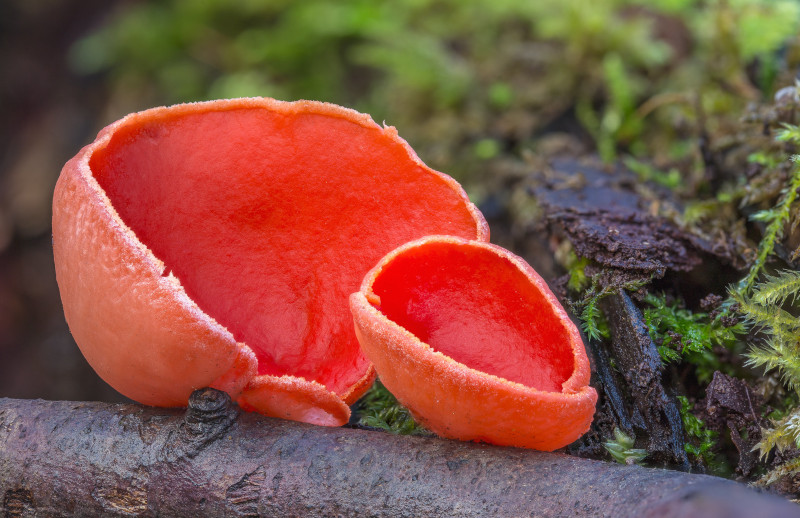
Scarlet Elf Cup Facts
- This intriguing product of Nature and evolution is best known by the descriptive common name of the Scarlet Elf Cup for obvious reasons. The fungus does, however, have several other general titles. These terms include Moss Cup, Fairies Baths, and simply Scarlet Cup.
- Within the scientific world, though, it’s perhaps much better known by its purely technical moniker. Unfortunately, that’s an extremely difficult term for the layperson to pronounce. That’s because the unique fungus holds the official epithet of Sarcoscypha coccinea.
- It received that hard to utter designation due to the efforts of Jean Baptiste Émil Lambotte. The respected Belgian mycologist applied the name to this natural marvel that it holds today. He did so in the year 1889. But, this moniker wasn’t the original name of the unique species.
- The credit for that achievement goes to the Italian naturalist Giovanni Antonio Scopoli. This highly noted researcher accomplished the first recognition of it as a separate and distinct species, though he applied a different tag. This scientifically noteworthy deed occurred in 1772.
- Thankfully, the remarkable Scarlet Elf Cup continues to maintain a population base that’s both stable and sufficient. That pleasant state also seems to hold true throughout the entirety of its range. the IUCN therefore currently does not show it on the Red List of Threatened Species.
- The wonder nevertheless should still be considered as facing the same potential threats to its continued existence as all species on earth today. Like the rest of us, most of those dangers stem from the actions of man, and include the perils of habitat loss and climate change.
Related Articles
Scarlet Elf Cup Physical Description
The stunning Scarlet Elf Cup dazzles those individuals fortunate enough to encounter this amazing marvel of Nature. The fabulous fungi typically does so, however, due more to its brilliant hue than its sheer size. That’s true since it actually ranks as a comparatively small variety of mushroom.
Its form varies in nature somewhat, though, regarding the structure known as its stem. Most specimens lack a distinct version of such a feature, yet a few exceptions do manifest one. Those examples that do produce this structure, however, typically show a relatively short, stubby version.
Younger examples of this visually intriguing fungus generally have a generally spherical shape, while, mature specimens display a roughly cup-shaped form. This also tends to be comparatively shallow in nature. Adding to its visual appeal comes the fact that it also possesses rolled-up edges.
Despite its numerous wonders, however, it’s undeniably a small species of mushroom. It’s also quite variable in this respect. The fruiting bodies usually range in width from about 04. 2.4 in (1 – 6 cm). Though exceptional examples sometimes do occur, they rarely exceed this by very much.
The most striking feature of the stunning Scarlet Elf Cup remains its vibrant red color, though. The outer surface of the fungus usually shows a deep scarlet or crimson hue, while the inner surface frequently varies from a paler pinkish-red to a deeper red. Other variants do exist, including orange.
The surface often appears extremely smooth when young, becoming slightly wrinkled with age, with the texture feeling rubbery. Inside, you’ll find a smooth, shiny surface that contrasts sharply with the outer texture. This sometimes has a more translucent appearance compared to the outer layer.
- Kingdom: Fungi
- Phylum: Ascomycota
- Class: Pezizomycetes
- Order: Pezizales
- Family: Sarcoscyphaceae
- Genus: Sarcoscypha
- Species: S. coccinea
Scarlet Elf Cup Distribution, Habitat, and Ecology
The Scarlet Elf Cup evolved as native to an extraordinarily broad swathe of the surface of the earth. In fact, the full extent of that zone of habitation covers much of the Northern Hemisphere. The marvel appears in Africa, Asia, Europe, North and South America, and even Australia.
In North America, it’s especially common in the eastern United States, where it’s found in states such as Connecticut, Virginia, Maryland, and others. It’s also in the midwest and western sections, in states like Ohio, Michigan, Oregon, and Washington. It appears in the nation of Canada, too.
Meanwhile, in Europe, the marvel of Nature remains equally widespread. Many countries such as the United Kingdom, France, Germany, and Scandinavia are known to have substantial populations of this fungus present. In Asia, it’s also extremely common on the island country of Japan.
This remarkable creation of evolutionary processes additionally displays decidedly clear and strong preferences regarding its choice of habitat. Like all of its countless relatives located around the world, this amazing fungus thrives best in comparatively moist or humid environments.
Because of this, it’s commonly found either in areas with ample quantities of rainfall or where there’s frequent moisture, such as near streams, in damp woodlands, or in areas with high humidity levels. In these same areas, it’s also typically located under the canopy of trees, in the shade.
The impressive Scarlet Elf Cup evolved as a saprophytic fungus, meaning it obtains its nutrients by decomposing dead organic matter. It primarily grows on decaying hardwood logs, branches, or stumps. It’s often found on fallen or rotting wood, especially in advanced stages of decay.
Its fruiting bodies generally appear in late winter to early spring, often coinciding with periods of cooler temperatures and moisture. The red or orange cup-shaped structures develop to release its spores, which it disperses by various means, primarily including wind, rain, and animal activity.
Species Sharing Its Range
Check out our other articles on 4 Intriguing New Zealand Insects, Rice’s Whale, Table Mountain, Rose’s Ghost Frog, Old World Swallowtail, Southern Stingray, Alligator Snapping Turtle
